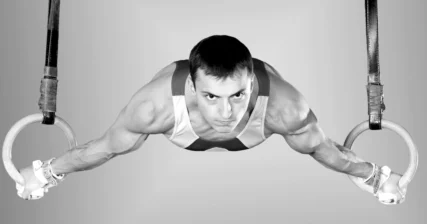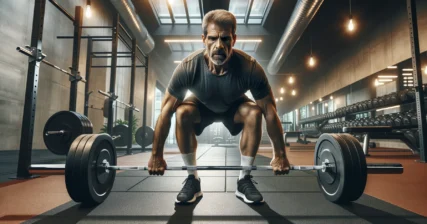Listen on: Apple Podcasts | Spotify
Over the past couple of decades in working with men and women, I’ve consistently seen that women benefit from cardio more than men. Most of the time, when a guy starts eating better and lifts weights, he gets leaner. However, I’ve noticed that for most women, to get leaner, they need to do some cardio in addition to their resistance training.
While I don’t have specific research to back it up, I’ve found that women do best when they split up their resistance training and cardio between a 50/50 and 70/30 weight training to cardio mix. That’s why Resilient works so well for women, whereas Vigorous works better for men (you can read more about my training programs here: VIGOR Training).
With that said, there is research to support the idea that women need to do some cardio in addition to lifting weights. That’s what we’ll focus on in this article.
What do you mean by “cardio” or “aerobic exercise?”
Aerobic exercise is any physical activity you can perform for an extended period of time, that gets your heart rate up, and increases blood flow to your muscles. Think running, swimming, cycling, or even dancing. These exercises utilize oxygen to fuel your body, providing a sustained energy source that helps you go the distance. When you perform aerobic exercise, you burn primarily fat.
Anaerobic exercise, on the other hand, is an intense physical activity you can perform for a limited period of time. Anaerobic exercise relies primarily on carbohydrates or glucose (sugar) for fuel.
So, cardio can be aerobic or anaerobic, depending on the activity and your level of fitness. That brings us to heart rate zones, a way for you to use your heart rate to estimate whether you’re workout is more aerobic or anaerobic so you get the most benefit from the time you put into it. I should also mention that heart rate zones do not apply to strength training. They’re only useful when doing cardio.
Heart Rate Zones
To maximize the benefits of your cardio workouts, it’s important to understand heart rate zones. These zones represent different intensity levels of exercise, measured as a percentage of your maximum heart rate (MHR), which varies with age.
Determining your maximum heart rate (MHR) is key to effectively utilizing heart rate zones in your training. Here are two common ways to find it:
The Age-Based Method: This is the most straightforward method and simply requires some basic math. The formula is 220-age=MHR.
For example, if you’re 30 years old, your estimated MHR would be 190 beats per minute (BPM). However, keep in mind this is a rough estimate and individual rates can vary.1Tanaka, H., Monahan, K. D., & Seals, D. R. (2001). Age-predicted maximal heart rate revisited. Journal of the American College of Cardiology, 37(1), 153-156.
Max Heart Rate Test: This is a more accurate method, but it’s also more demanding and should only be performed if you’re in good health and ideally under professional supervision. Here’s how it generally works:
- Start with a warm-up of light cardio, like jogging or cycling, for about 10-15 minutes.
- Gradually increase your intensity until you’re working as hard as you can.
- When you reach your maximum effort (when you can’t go any harder or faster), note your heart rate. This is your MHR.
You can measure your heart rate using a heart rate monitor, a fitness tracker, or manually at your wrist or neck. Remember, this test is demanding, so it’s important to listen to your body and stop if you feel dizzy, lightheaded, or excessively breathless.2Robergs, R. A., & Landwehr, R. (2002). The surprising history of the “HRmax= 220-age” equation. Journal of Exercise Physiology Online, 5(2), 1-10.
There are five zones, each with its unique characteristics:
Zone 1 (50-60% MHR): This is the very light-intensity zone. Activities in this zone feel effortless, like a leisurely walk. Your body primarily uses fats as an energy source and you can maintain this activity level for hours.
Zone 2 (60-70% MHR): Welcome to the light-intensity zone. Activities here might include a brisk walk or a slow jog. Your body still mainly burns fat, with a bit of carbohydrates, and you can maintain activities in this zone for a long time. This is an excellent zone for building endurance and promoting recovery.
Zone 3 (70-80% MHR): This is the moderate-intensity zone. Think of a steady, moderate bike ride or jog. Your body starts to use more carbohydrates for energy but can still keep up with fat burning. You might be able to maintain this activity level for up to two hours. This zone is perfect for improving aerobic capacity.
Zone 4 (80-90% MHR): You’re now in the high-intensity zone. This level of activity is challenging to maintain for an extended period; you might last between 30 minutes to an hour. Here, carbohydrates become the dominant energy source.
Zone 5 (90-100% MHR): This is the maximum intensity zone. It’s tough and can only be maintained for a short period, like during a sprint finish. Your body predominantly uses carbohydrates for quick bursts of energy in this zone.
Calculate Your Heart Rate Zones
Most of your cardio workouts should be spent in Zone 2 and Zone 3. Activities in these zones can be sustained for longer periods, allowing you to burn more total calories and, importantly, a greater proportion of fat calories. They’re also less strenuous on your body, reducing the risk of injury and promoting recovery, as well as lowering stress and anxiety.3Mann, T., Lamberts, R. P., & Lambert, M. I. (2013). Methods of prescribing relative exercise intensity: physiological and practical considerations. Sports Medicine, 43(7), 613-625.
Why Focus on Cardio for Women?: Now, back to our primary question – why does cardio seem to favor women more? Well, there are biological and physiological reasons that we’ll explore further in the next section. But for now, just know that when it comes to cardio, women often have a distinct edge.
Don’t abandon your dumbbells just yet! While this article leans towards the advantages of aerobic exercises for women, I want you to remember that resistance training remains vital for overall health, for both men and women. We’ll talk more about that later, but first, let’s dive into the science behind cardio and fat loss.
The Science Behind Cardio and Fat Loss
To grasp why cardio has a reputation for being a potent fat burner, especially for women, we need to delve a bit into the nitty-gritty of how our bodies burn fuel during exercise.
Cardio and Calorie Burning: When you engage in cardio exercises, your body primarily uses carbohydrates and fats as its fuel sources.4Brooks, G. A., & Mercier, J. (1994). Balance of carbohydrate and lipid utilization during exercise: the “crossover” concept. Journal of Applied Physiology, 76(6), 2253-2261. As the intensity of your workout increases, your body shifts more towards carbohydrates for quick energy. However, during moderate-intensity cardio (zones 2-3) – the sweet spot for many women – fats take center stage as the primary energy source.5Achten, J., & Jeukendrup, A. E. (2004). Optimizing fat oxidation through exercise and diet. Nutrition, 20(7-8), 716-727.
Women, Cardio, and Fat Burn: Here’s where it gets interesting for women. Research has found that women tend to burn more fat than men during aerobic exercise.6Tarnopolsky, M. A., Atkinson, S. A., Phillips, S. M., & MacDougall, J. D. (1995). Carbohydrate loading and metabolism during exercise in men and women. Journal of Applied Physiology, 78(4), 1360-1368. This is partially due to the influence of estrogen, a hormone that aids in breaking down fats for energy. So when a woman hits the pavement for a run, her body is wired to tap into fat stores more efficiently than men.
The Cardio-Fat Loss Connection: Cardio’s ability to burn fat doesn’t mean it directly causes fat loss. It’s part of a bigger picture. Fat loss occurs when you burn more calories than you consume, creating a calorie deficit.7Hall, K. D., Heymsfield, S. B., Kemnitz, J. W., Klein, S., Schoeller, D. A., & Speakman, J. R. (2012). Energy balance and its components: implications for body weight regulation. The American Journal of Clinical Nutrition, 95(4), 989-994. By burning calories, cardio can contribute to this deficit, aiding in fat loss.
Remember, though, cardio isn’t the be-all and end-all for fat loss or fitness. I can’t stress enough how crucial resistance training is in any balanced fitness program. But it’s worth noting that cardio holds its weight when it comes to fat burning – particularly for women.
Why Cardio Benefits Women More Than Men
By now, we understand how cardio helps burn fat. But let’s dig a bit deeper into why women seem to get more out of these sweat sessions than men.
Biological Factors: Remember our mention of estrogen earlier? This hormone, more prevalent in women, plays a significant role in how your body burns fuel during exercise.8Devries, M. C. (2016). Sex-based differences in endurance exercise muscle metabolism: impact on exercise and nutritional strategies to optimize health and performance in women. Experimental physiology, 101(2), 243-249. Estrogen can increase your body’s ability to burn fat for energy, meaning women often burn more fat than men during cardio workouts. This can provide an edge when it comes to fat loss.
Physiological Differences: There are also physiological differences between women and men that impact the effectiveness of cardio. Women tend to have a higher percentage of body fat and a lower percentage of muscle mass compared to men.9Blaak, E. (2001). Gender differences in fat metabolism. Current opinion in clinical nutrition and metabolic care, 4(6), 499-502. This lower muscle mass can make resistance training more challenging initially, making cardio a more approachable starting point for women new to exercise.
But don’t let this make you think resistance training should take a backseat. In fact, resistance training helps build muscle, which boosts your metabolism and aids in fat loss.10Westcott, W. L. (2012). Resistance training is medicine: effects of strength training on health. Current sports medicine reports, 11(4), 209-216. So while you might be smashing it on the treadmill, don’t forget to spend some quality time with the weight rack.
In essence, the inherent biological and physiological traits of women often make cardio a powerful tool in their fitness arsenal. But remember, balance is key, and resistance training remains essential to round out your fitness journey.
Improvement in Cardiovascular Health: Women, like men, can significantly reduce their risk of developing heart disease with regular cardio exercise.11Shiroma, E. J., & Lee, I. M. (2010). Physical activity and cardiovascular health: lessons learned from epidemiological studies across age, gender, and race/ethnicity. Circulation, 122(7), 743-752. However, research shows that high levels of physical activity can offset some risk factors more common in women, such as metabolic syndrome and inflammation.12Peters, S. A. E., Woodward, M., Jha, V., Kennedy, S., & Norton, R. (2020). Women’s health: a new global agenda. BMJ Global Health, 5(6), e002155.
Enhancement of Mental Health: Cardio workouts have been found to boost mood, reduce anxiety, and alleviate symptoms of depression in both sexes.13Carek, P. J., Laibstain, S. E., & Carek, S. M. (2011). Exercise for the treatment of depression and anxiety. The International Journal of Psychiatry in Medicine, 41(1), 15-28. But given that women are nearly twice as likely to experience anxiety and depression, these benefits are particularly important.14McLean, C. P., Asnaani, A., Litz, B. T., & Hofmann, S. G. (2011). Gender differences in anxiety disorders: prevalence, course of illness, comorbidity and burden of illness. Journal of psychiatric research, 45(8), 1027-1035.
Mitigation of Menopause Symptoms: Engaging in regular cardio can help alleviate some symptoms of menopause, including hot flashes, mood swings, and sleep disturbances.15Daley, A. J., Thomas, A., Roalfe, A. K., Stokes-Lampard, H., Coleman, S., Rees, M., … & Jowett, S. (2015). The effectiveness of exercise as treatment for vasomotor menopausal symptoms: randomised controlled trial. BJOG: An International Journal of Obstetrics & Gynaecology, 122(4), 565-575. Aerobic exercise can also counteract the drop in bone density that occurs during menopause, helping to prevent osteoporosis.16Palacios, S., Henderson, V. W., Siseles, N., Tan, D., & Villaseca, P. (2010). Age of menopause and impact of climacteric symptoms by geographical region. Climacteric, 13(5), 419-428.
Lowering Risk of Certain Cancers: Women who engage in regular aerobic activity have a lower risk of certain cancers, specifically breast and endometrial cancers.17Friedenreich, C. M., Neilson, H. K., & Lynch, B. M. (2010). State of the epidemiological evidence on physical activity and cancer prevention. European Journal of Cancer, 46(14), 2593-2604.
While these benefits are impressive, it’s important to note that they complement the benefits of resistance training rather than replace them. Resistance training offers unique advantages, such as increased strength, muscle mass, and improved bone health, which are essential for overall health and wellbeing. The goal should be to combine both forms of exercise for a well-rounded fitness program.
The Importance of Balance in Fitness
It’s clear that cardio holds some great cards in the deck when it comes to women’s fitness. But it’s not the only player in the game. As we’ve mentioned throughout this article, resistance training is a crucial component of any balanced fitness regimen.
Resistance Training and Muscle Building: Resistance training, such as lifting weights or bodyweight exercises, builds muscle mass.18Westcott, W. L. (2012). Resistance training is medicine: effects of strength training on health. Current sports medicine reports, 11(4), 209-216. For women, this is particularly important as it can offset the natural loss of muscle that occurs with aging. More muscle mass can boost your metabolism, aiding in fat loss and providing a well-rounded approach to fitness.
Bone Health: Resistance training is also essential for bone health. It helps increase bone density, which is critical for women, who are at higher risk of developing osteoporosis, especially post-menopause.19Howe, T. E., Shea, B., Dawson, L. J., Downie, F., Murray, A., Ross, C., … & Harbour, R. T. (2011). Exercise for preventing and treating osteoporosis in postmenopausal women. The Cochrane database of systematic reviews, (7), CD000333.
Body Composition: Resistance training helps change your body composition. By building more muscle, you can create a lean, strong, and toned physique. It’s important to remember that fitness isn’t just about the number on the scale but how you feel in your body.
While aerobic exercise has its unique place and provides significant benefits for women, it should be part of a well-rounded exercise regimen that includes resistance training. Striking a balance between cardio and resistance training is the best way to optimize your health, boost your fitness, and achieve your goals.
Remember, every woman’s body is unique, and what works best for you may not work as well for someone else. Find the balance that makes you feel strong, empowered, and healthy. But remember this: what you enjoy doing and what actually gets results may not be the same thing. Sometimes, you need to do exercise you don’t enjoy, so that you can enjoy all the other things life has to offer when you’re fit and healthy.
Practical Summary
When it comes to improving health, boosting fitness, and facilitating weight loss, cardio offers a powerful tool, especially for women. Thanks to benefits like increased calorie burning, improved cardiovascular health, and heightened brain function, cardio exercise stands out as a significant element in a well-rounded fitness regimen.
Remember, though, that fitness isn’t a one-size-fits-all journey, and your best approach combines cardio with resistance training. By engaging in both forms of exercise, you leverage the unique benefits they offer – the fat-burning and heart health of cardio, along with the muscle-building and bone-strengthening of resistance training.
And don’t forget the power of heart rate zones. These handy benchmarks can help guide your workouts to ensure you’re getting the most out of your sweat sessions. Consider using a heart rate calculator or a fitness tracker to easily find your zones and track your progress.
Finally, remember that every body is unique. Listen to yours, find a balance that feels right, and make the most of your fitness journey. The goal isn’t perfection but progress every day – and every step, lift, or pedal stroke gets you closer.



